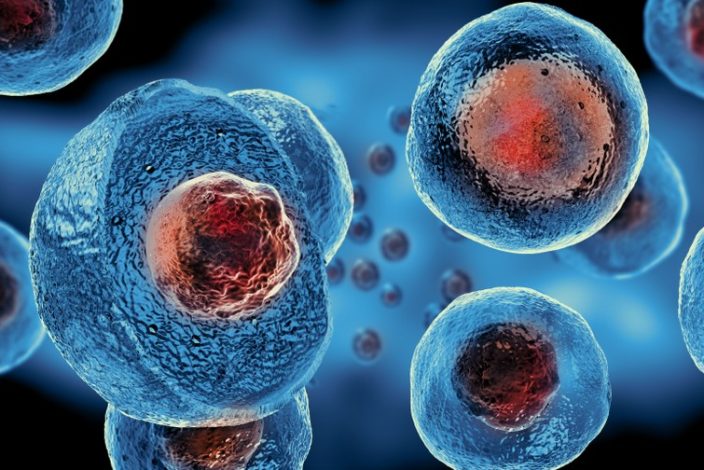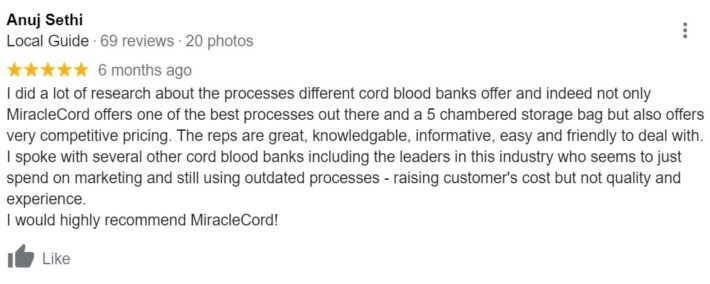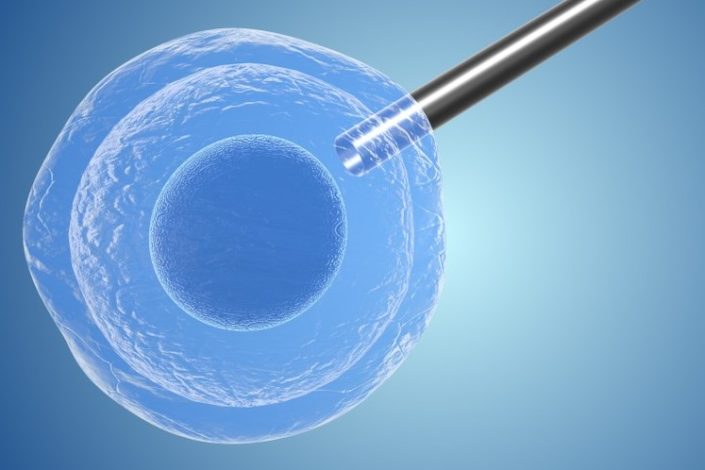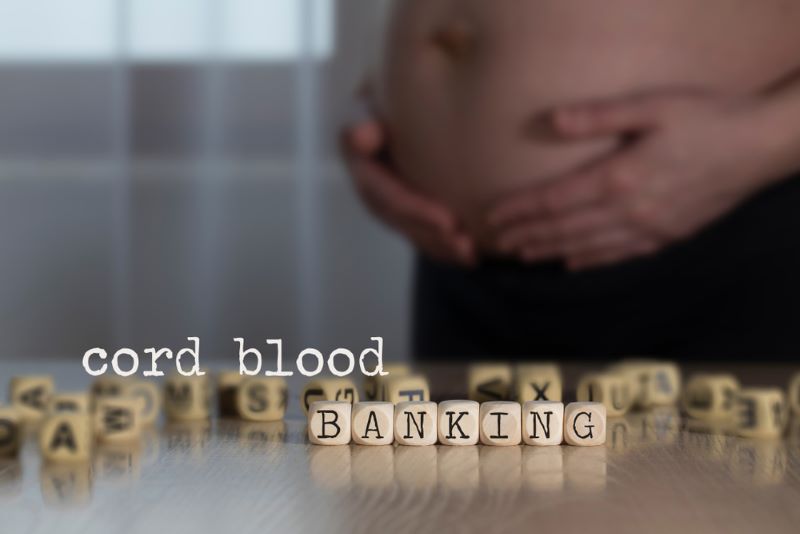Whether you are newly pregnant or only a few weeks away from giving birth, you want to be able to give your little one the best in life.
By banking your baby’s cord blood and cord tissue, you may be taking the most important step in protecting their future.
With new advances in stem cell therapy, the number of diseases treatable using stem cell technology is ever increasing.
Cord blood banking allows your child to access a wide range of current and future treatment options through stem cell therapy.
This could help give your baby a fighting chance should life throw one of these terrible illnesses their way. And provide them with treatment options developed from their own cells.
What is Cord Blood?
Cord blood is blood which remains in the baby’s umbilical cord, and placenta following childbirth. It’s gathered right after the cord is cut.
Cord blood is rich in stem cells, which can treat various diseases using stem cell therapy.

What are Stem Cells?
Stem cells are the ‘master cells’ of our body. This is because they can develop into different types of cells within the body. These include nerve cells, blood cells, muscle, or brain cells.
They have the ability to repair damaged tissue or to regenerate new tissue. This makes their potential applications in treating diseases extensive.
Today’s stem cell technology can treat over 80 diseases using FDA-approved therapies.
One example is stem cell transplants to generate bone marrow in leukemia patients. In this particular treatment, a child’s own stem cells have a greater chance of being accepted by the body than those of a sibling or relative. (1)
Looking to the future, the number of diseases that stem cells could help treat is ever-growing. It’s estimated 1 in 3 Americans will need some form of regenerative therapy in their lifetime. (2)
What is Cord Blood Banking?
Cord blood banking is a way of preserving those unique stem cells found in the blood of your baby’s umbilical cord.
They are processed and then cryogenically frozen for many years. This is so that your child can use them in the future should they develop a disease treatable by stem cell therapy.
As the current and potential future use of stem cells is extensive, an increasing number of parents are choosing to store their baby’s stem cells in private blood banks.
Future treatments could include cancers, multiple sclerosis, type 1 diabetes, and Parkinson’s disease.
Benefits of Private Blood Cord Banking
MiracleCord is a private cord blood registry. There are many benefits to choosing a private cord blood bank over public banks.
Privately banked cord blood cells can be used solely by the donor or their family. In contrast, cord blood cells stored in public banks can be used by anyone who may need them for a transplant.
If your child gets sick, you have a stem cell match that can be readily used when needed.

Cord Blood vs Cord Tissue
Cord blood contains hematopoietic stem cells that are used to make up the blood and the immune system. In contrast, cord tissue contains mesenchymal stem cells used to make the organs, the nervous system, arteries, bones, and more.
Each of these stem cells yields very different therapies and can be used to treat different conditions. Both of these cells can be found in the umbilical cord that connects your baby to you.
Cord blood stem cells are taken from the excess blood found in the umbilical cord and placenta after birth. In comparison, cord tissue stem cells are taken from a piece of the actual umbilical cord itself.
Treatments with cord blood stem cells are already being used today, for example, with leukemia patients. For that reason, cord blood storage is better known than cord tissue storage. (3)
On the other hand, cord tissue cells are under heavy research for treatments of diseases such as type 1 diabetes, strokes, and heart muscle function for people with heart failure. There are over 300 clinical trials on-going. (4)
MiracleCord offers banking for both cord blood stem cells and cord tissue stem cells:
MiracleCord Cord Blood and Tissue Registry
MiracleCord is a private service that provides Cord Blood Banking and Cord Tissue Banking.
It stores viable blood and tissue samples in an AABB accredited and FDA-approved cryogenic storage facility for a period of time of your choosing.
These samples are kept available to you should you need them in the future for stem cell therapies.
You can store either cord blood samples or cord blood and cord tissue samples with them.
You can also choose how long you want to store them. Their plans go all the way up to a lifetime storage plan of 70 years.
Is MiracleCord the Best Cord Blood and Tissue Registry in the US?
We find MiracleCord to be one of the best cord blood banking companies in the US due to the advanced techniques they use to protect cord blood and cord tissue samples.
We go into exactly what these techniques are below. They both increase the chances of the cord blood and tissue cells’ viability and increase the number of stem cells that can be stored.
After collection, stem cells are stored in a secure cryogenic storage facility. MiracleCord also offer their customers a price match guarantee against other services so that you’re sure you’re getting the best price on the market.
Cord Blood Viability and How MiracleCord Maximizes Baby’s Stem Cell Viability
A critical part of Cord Blood and Tissue storage keeping the cells viable until they reach the laboratory.
If they’re not viable, they cannot be used or stored, and the opportunity to use those particular cells is lost.
MiracleCord has taken certain key steps to increase the chances of the viability of these cells.
These go over and above what many other services offer, which is why they’re our preferred service:
Average Processing Time of 12 Hours from Collection
Time is an important factor in maintaining the greatest number of viable stem cells. The faster the samples reach the laboratory and are processed, the more likely they will be viable.
One study shows that processing samples within 12 hours can preserve as much as 2.8x more cells than processing within 24 hours. (5)
Many other cord blood banks have an average processing time of 24 hours or more. However, MiracleCord’s ‘Time Critical Processing’ has an average of just 12 hours from collection.
Thermal Technology with their StemCare Collection Kit
Changes in ambient temperature can affect the cord blood and cord tissue cells. So it’s important to keep the temperature constant while the samples are in transit.
MiracleCord use their own exclusive thermal technology in their sample collection kits. This protects the stem cells from changes in temperature while they’re being delivered to their laboratories.
A constant temperature increases the chances of the cells being viable when processed.
Their StemCare collection kit is also FDA-approved and sterile.
Heparin-Free Cord Blood Collection
Heparin is a blood thinner that is used by some cord blood banks to prevent the cord blood sample from clotting.
However, heparin begins to break down after 12 hours, and this could lead to clotting. If the blood clots, the cells can’t be processed.
Instead of heparin MiracleCord use CPD – Citrate Phosphate Dextrose – to thin the blood. This prevents it from clotting for longer and is also recommended by the FDA.
A recent study compared two blood samples, one with CPD and one with dry Heparin. The CPD sample gave as many as 58% more viable cells than the one using Heparin.
Better Stem Cell Counts with AXP II AutoXpress Processing
MiracleCord use an AXP II AutoXpress system to process cord blood and tissue samples.
This is a new technique that uses optical sensor technology to isolate the cord blood’s stem cells.
It also keeps the cells in a sterile environment, reducing the risk of the samples being contaminated.
Studies show that this method can recover 99% of cells, 20% higher than certain other processing methods.
So the AutoXpress Processing can give a higher cell yield.
$100,000 Stem Cell Quality Guarantee
To show their confidence in their stem cell collection process, MiracleCord offer a $100,000 Quality Guarantee.
If the cord blood from one of their samples is used for a stem cell transplant and those stem cells fail to engraft, they will provide you with $100,000 so that you can find an alternative source of stem cells.
This guarantee is subject to its own terms and conditions, but overall, it’s a huge vote of confidence in their storage processes.
It also shows that they understand just what these stem cells mean to families, should they have to use them in treatments.
Best Price Guarantee
While they want to provide the best quality, MiracleCord also wants to provide the best on price.
They are currently offering to match the price from any other company for a comparable service if it’s shown to be cheaper.
This gives customers confidence that they are getting the best price with MiracleCord.

What else is included in the MiracleCord package?
MiracleCord also offer a direct courier service, which comes with all of their packages at no additional charge.
A courier trained to deal with human tissue sample deliveries is available 24 hours a day, 7 days a week, all year round. So you can count on them even if your baby decides to make their grand entrance during a holiday!
They are also one of the few services not to lease out the delivery to third-party services like FedEx to give the most reliable delivery.
MiracleCord Reviews
MiracleCord currently has 5 out of 5 stars from 19 reviews on Google.
Reviews generally cited that they liked how MiracleCord arranged:
- Prompt delivery of the sample collection kit.
- Direct courier from the hospital to the laboratory.
- Competitive pricing.
- Excellent customer service.
At the time of writing, we were unable to find a negative review about this service.
One user said that they had used the service twice already and were very happy with them:

Another user found their methods to be better than those of other laboratories:

What Are the Pros and Cons of Cord Blood Banking with MiracleCord?
Here is a brief round-up of the pros and cons of cord blood banking with MiracleCord:

|
|
| Pros | Cons |
| The potential of creating a life-saving treatment for your baby in the future. | Can be a costly process with a fee for sample processing and a fee for storage. |
| Poses no harm or risk to the mother or baby. | There is always a chance that the sample won’t be viable, although MiracleCord are one of the best at securing viable cells. |
| Banked samples can be stored for a very long period of time, up to 70 years. | The effectiveness of future stem cell treatments are still unknown. |
| MiracleCord can collect cord blood or both cord blood and cord tissue stem cells. | |
| Direct medical courier service. | |
| High stem cell yields using per sample using AXP II advanced automated processing which affects future treatment options. | |
| $100,000 Stem Cell Quality Guarantee | |
| Best price guarantee as they will match any price on the market. | |
MiracleCord Cord Blood and Tissue Storage
How Does Cord Blood Banking Work?
You can sign up through the MiracleCord website by clicking ‘Enroll Now’. It then shows you the different plans available.
Select Your Package and Payment Options
You can choose from:
- Storing only cord blood or both cord blood and cord tissue.
- Storing annually, for 20 years, or for 70 years – lifetime plan.
- Paying upfront or in 12-month installments.
The storage costs are only billed when the cord sample is collected, and the storage plan is confirmed.
There is an additional $200 deposit, which is paid upfront. This is non-refundable as it covers the processing of the cord blood and tissue samples.
Once the plan is selected, you fill out the forms to complete registration and get your StemCare Collection Kit on its way to you!
Planning the Birth
It is recommended you sign up well before your due date. This is so that you have enough time to receive your cord tissue collection kit and include it in your hospital bag.
Collection of the Cord Blood Sample
Let your doctor know about which specimens you wish to collect, cord blood cells or cord blood and tissue cells. He will need to confirm beforehand that he is able to do the sample collection.
As soon as you give birth, your doctor can take the samples and store them in the StemCare Collection Kit.
Arrange the Medical Courier Pick-up
Once the cord tissue and/or cord blood has been collected, you contact the medical courier.
They come and pick up your completed kit directly from the hospital and take it straight to the laboratory.
The couriers are available 24-7 to get the sample to the lab as quickly as possible.
Processing of the Cord Samples
Once the sample reaches the laboratory, it is tested to check that the cells are viable and can be stored.
Once the viability of the sample is confirmed, they will be prepared for cryogenic storage.
Cord Blood and Cord Tissue Storage
The cord blood and tissue cells will be frozen in liquid nitrogen tanks and stored in their registered laboratory.
At this stage, you will receive a certificate of storage and a detailed lab report of your baby’s cord blood and tissue cells.
Packages offered by MiracleCord
There are various packages and pricing options available depending on whether you want to bank only your baby’s cord blood cells, or you want to bank both cord blood cells and cord tissue cells.
Cord blood cells can be used to treat some types of blood cancers including leukaemia; and cord tissue cells are showing promising results in treating a wide range of diseases such as multiple sclerosis. (6)
There is also a second option to choose from which asks how long you would like the collected cells to be stored.
The table below outlines the packages and prices available:
 |
Type of cells: |
Deposit ($): |
One-time payment ($): |
12-month payment plan ($ per month): |
| First Year Storage Plan | Cord blood | 200 | 1195 | 109 |
| Cord blood and tissue | 200 | 1695 | 155 | |
| 20-year Storage Plan | Cord blood | 200 | 2495 | 228 |
| Cord blood and tissue | 200 | 3995 | 366 | |
| Lifetime Storage Plan | Cord blood | 200 | 4995 | 457 |
| Cord blood and tissue | 200 | 7995 | 732 |
MiracleCord Packages
What Diseases Can Cord Blood Stem Cells Treat?
Currently, stem cell therapy can routinely treat over 80 diseases, including:
- Immune disorders such as myelokathexis and Wiskott-Aldrich syndrome.
- Blood disorders such as acute myelofibrosis and sickle cell disease.
- Metabolic disorders such as Hunter syndrome and Mucolipidosis II.
- Many types of cancers such as chronic active Epstein Barr, neuroblastomas, and non-Hodgkin’s lymphoma.

How Long Can Cord Blood Cells be Stored For?
Cord blood cells can be stored for more than 20 years of storage and remain in the same condition.
Studies have found that they were viable for as long as 23.5 years after being frozen. (7)
What Storage Method Does MiracleCord Use?
All blood samples are stored in nitrogen tanks in their laboratory. MiracleCord state that these are the ‘largest bulk nitrogen tanks in the country.’
The laboratory itself is AABB accredited and FDA-registered. It also has 20 years’ experience handling cord blood.
The samples have temperature-monitoring over multiple layers. They also have back-up power sources and generators to keep the samples safe even if there is a large power-outage.
Is MiracleCord a Good Company?
We would say that MiracleCord is a good company as it offers high standards of cord blood and tissue processing and storage.
They use a specialized and reliable storage facility for longterm storage. They also employ quality practices in terms of how they transport and process the cord samples after birth.
Add to that, that they provide a $100,000 guarantee if, for some reason, their stem cells fail to engraft during stem cell treatment.
Is There Anything Else I Should Know?
It’s advised that cord blood banking is done for all children and not just one.
This is because the chances of one sibling’s stem cells being a perfect match for another sibling’s treatment is about 25%.
So if you want your baby to have the option of using their own cells, they need to be stored independently.
Is MiracleCord Worth It?
Yes, Miracle Cord is worth it as it provides a secure and reliable storage service for cord blood and cord tissue cells in their accredited laboratory.
Packages run for as long as 70 years. This means you can store your child’s stem cells for a lifetime. You could use them for treatments that exist today as well as for treatments that are developed in the future using stem cell research.
Miracle Cord offers cord blood storage and cord tissue storage, which is not provided by all services.
Their average time to process the cord samples is 12 hours on average from collection, versus 24 hours from other services. This faster speed increases the number of viable cells in the sample.
MiracleCord follows the correct protocol in terms of gathering the samples. Their collection kits are temperature controlled – to keep the cord blood and tissue at the same temperature in transit.
They also use CPD over heparin to prevent blood clotting, which can last longer. And they use their own courier service rather than sub-contracting the delivery out to third parties.
Finally, they process the cells in a way that reduces the chances of contamination and preserves as many stem cells as possible.
So in all, they are an experienced medical team in the cord blood and tissue area that offer a reliable service.
In addition they have a $100,000 stem cell quality guarantee for added peace of mind. This is where they pledge to pay you this amount if their stem cells fail to engraft during treatment, so that you can find alternative stem cells.
MiracleCord Packages
MiracleCord FAQs
Can cord blood cells be used to treat leukemia in both adults and children?
Yes, stem cell transplants have been used on children and adults with leukemia for a number of years and have the ability to provide lifesaving treatments.
Does MiracleCord perform the required testing on my cord blood?
Yes, they perform extensive testing on cord blood using an advanced processing method, which also lowers the risk of contamination.
Where is MiracleCord Stored?
MiracleCord’s laboratory and cryogenic storage facility are located in Arizona.
Is treatment using cord blood stem cells considered “experimental”?
No cord blood stem cell treatments are no longer considered experimental. There has been more than 30 years of extensive research into cord blood stem cells. Today, FDA-approved stem cell treatments exist for over 80 diseases.
Is cord blood banking worth it in 2021?
Yes, cord blood banking is worth it in 2021 as many potentially lifesaving stem cell treatments are already available. Thousands more are in clinical trials. Therefore, it could be an investment that provides your child with a similarly lifesaving treatment in the future.
How long can cord blood stem cells stay in storage?
Research has shown that cord blood stem cells have shown to be viable and in the same condition as the day they were frozen, after as long as 23.5 years.
How can I ensure my baby’s stem cells will be processed in time?
MiracleCord use their own direct courier service to pick up your kit from the hospital and to transport it to their laboratory. They ensure it is processed as quickly as possible, ideally within 12 hours.
Does insurance pay for cord blood banking?
Some insurance companies may offer cord blood banking coverage depending on the terms of your individual or group policy. You should contact your own insurance company for more details.
Is MiracleCord’s laboratory AABB accredited?
Yes, MiracleCord’s laboratory is both AABB accredited and regulated by the FDA.
Does MiracleCord Offer Placental Tissue Storage?
MiracleCord do not offer placental tissue storage as they find it unnecessary if you are already storing cord tissue. They state that the stem cells derived from the placental tissue (mesenchymal stem cells, also known as MSC’s) are the same as those that come from cord tissue. Since those cell numbers can be multiplied, there is no need to store the placental cells separately.
MiracleCord Packages
References
- Cord-Blood Transplants Show Promise in Leukemia Treatment – Health Day
- Umbilical cord stem cells show promise as heart failure treatment – American Heart Association
- Optimal timing for processing and cryopreservation of umbilical cord haematopoietic stem cells for clinical transplantation
- Clinical feasibility of umbilical cord tissue-derived mesenchymal stem cells in the treatment of multiple sclerosis
- Cord Blood Infusion for Children with Autism Spectrum Disorder (Duke ACT)
- Cord blood stem cells: a review of potential neurological applications
- Stem Cell Transplant for Acute Myeloid Leukemia (AML) – American Cancer Society



